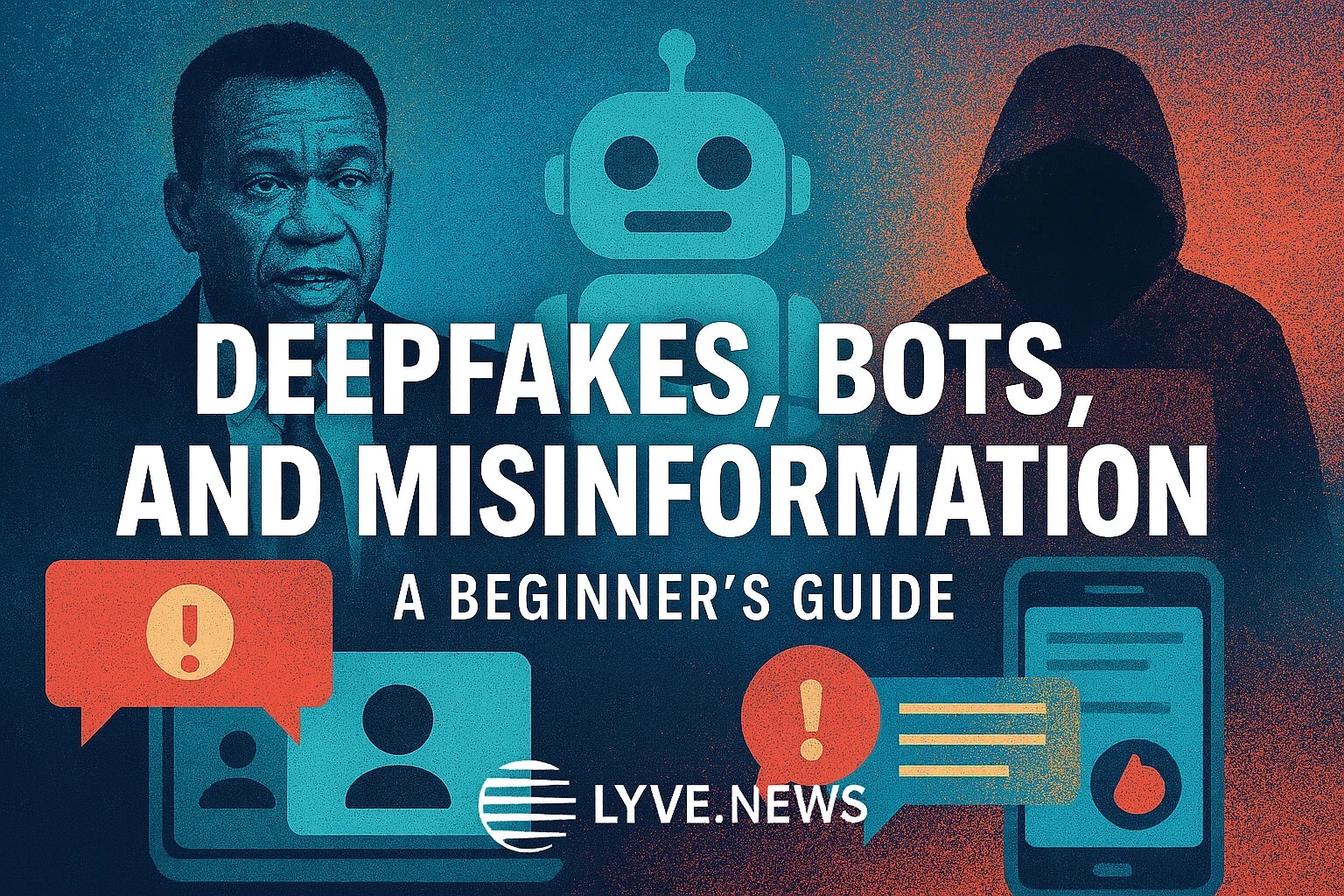Deepfakes, Bots, and Misinformation – A Beginner’s Guide
From TikTok fakes to WhatsApp rumours — how lies spread, why they work, and how to fight back.
This is LYVE Originals — where Africa’s future gets a voice.
The Clip, the Group Chat, and the Outrage
It starts small.
One clip, fifteen seconds. I saw one like this during the last Ghana polls — a candidate saying something that would have ended their career. Calm tone, steady eye contact. Felt real enough to make you lean closer.
By the time you’ve decided whether to believe it… too late. It’s already in the family WhatsApp group. The one where your uncle types in all caps, your cousin drops memes without context, and someone’s always forwarding an unverified voice note “just in case.”
“Eii, have you seen this?”
“This country, hmm…”
“Better share before they delete it.”
It’s slick. Emotional. And yeah — more often than not — fake.
Welcome to the age where a well-timed video can sprint faster than any fact-check. Outrage is the fuel, and it’s cheap.
Misinformation, Disinformation, and Malinformation — Not All the Same Beast
We call it all “fake news,” but that’s like calling every fruit in Makola Market a mango. They’re not the same — and they don’t rot the same way either.
-
Misinformation → Wrong info, no bad intent.
- Example: Your aunt sharing a miracle cure for malaria she heard on a late-night radio call-in.
-
Disinformation → Lies crafted to deceive.
- Example: A fake campaign ad dropped two nights before voting.
-
Malinformation → Truth, sharpened into a weapon.
- Example: A real flood photo from 2015 re-shared today to make the current government look careless.
Here, these aren’t theory. They’ve sparked street protests, scared parents out of vaccinating their kids, and turned peaceful election queues into shouting matches.
The Engine Room of the Mess
The tools aren’t mysterious — but they work because they’re relentless.
Bots
Software on autopilot, pretending to be people:
- Flooding hashtags until they feel organic.
- Liking and sharing the same narrative till it becomes background noise.
- Making fringe ideas look like the neighbourhood consensus.
They never sleep, never get tired. And they’re cheaper than hiring ten campaign volunteers.
Troll Farms
Actual humans, working from dingy rooms or tidy offices. Paid to provoke. Paid to harass. Paid to repeat a script until you start thinking you’ve heard it everywhere.
Some don’t even care about the politics — it’s just another hustle.
Deepfakes
The new heavyweight. AI-generated faces and voices that look, move, and sound real. They can:
- Put fake words in a president’s mouth.
- Create a journalist reading a fabricated bulletin.
- Manufacture a confession that never happened.
And by the time you’ve figured out the trick… it’s already done its damage.
Where the Lies Hatch and Spread
They don’t start on the nightly news. They live where we’re relaxed and less guarded.
- WhatsApp & Telegram → The family trust zone. “It came from my uncle, so it must be true.”
- TikTok → All emotion, no pause button.
- Facebook & X → The big open stage, easy for bots to hijack.
Remember: platforms care about engagement, not accuracy. Outrage gets a VIP pass.
Why Africa Keeps Getting Picked as the Test Lab
We’re fast adopters — and that’s both strength and weakness.
- Large, young, mobile-first audiences.
- Mixed media literacy — one fact-checker in the group, nine fast-forwarders.
- High political stakes, with elections that can tip on perception alone.
- Places where social media is the news.
From fake Ebola scares in Uganda to AI-generated smears in Kenya, we’ve seen the rehearsal — and the main show.
Spotting the Rot Early
You don’t need a tech degree. You need habits and a pause button.
- The emotion spike → If your pulse jumps, slow down.
- No credible source → If you can’t trace it, park it.
- Odd visuals → Shadows, lip sync, backgrounds that don’t match.
- Reverse search → Sometimes that “breaking” photo is from a totally different country.
- It spreads too fast → If it’s in ten WhatsApp groups but nowhere else, something’s off.
Keeping Your Digital Immune System Strong
- Turn off auto-downloads for media. Saves data and slows the impulse to share.
- Bookmark Africa Check, PesaCheck, Dubawa.
- Use tools like InVID for videos.
- Follow actual reporters, not just the loudest personalities.
- Correct gently. No one listens to a lecture.
The Real Battle: It’s Trust, Not Just Truth
Facts can be fixed — but trust? Once it’s cracked, it leaks forever.
Disinformation doesn’t just plant lies. It makes you doubt everything. Even the good stuff.
So the next time something dramatic lands in your inbox, don’t just react. Breathe. Check. Ask.
Because in this new reality, the sharpest weapon you have isn’t an app. It’s your own judgement.
Why This Guide Exists — and Why LYVE+ Matters
At LYVE, we’re not satisfied with just spotting the lie. We follow the paper trail — the contracts, the strategy memos, the quiet handshakes behind the campaign.
LYVE+ members get:
- Deep dives into how these campaigns are designed and paid for.
- Interviews with Africa’s frontline fact-checkers and investigators.
- Early alerts on emerging tech threats before they go mainstream.
If you want to understand not just what is happening, but how and why, join LYVE+. Because the only thing more dangerous than a lie… is not seeing it coming.
Get More Tech Insights
Subscribe to our weekly newsletter for the latest in African technology innovation.
